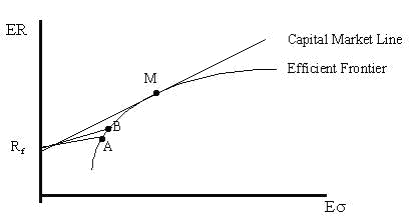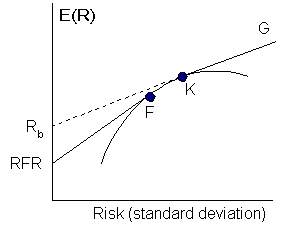- CFA Exams
- 2026 Level I
- Topic 9. Portfolio Management
- Learning Module 2. Portfolio Risk and Return: Part II
- Subject 1. Capital Market Theory
Why should I choose AnalystNotes?
AnalystNotes specializes in helping candidates pass. Period.
Subject 1. Capital Market Theory PDF Download
Introduction of a Risk-Free Asset
Adding a risk-free asset to the investment opportunities present on the efficient frontier effectively adds the opportunity to both borrow and lend. A U.S. Treasury bill (T-bill) is a common risk-free security proxy. Buying a T-bill loans the U.S. government money. Selling a T-bill short effectively borrows money. The concept of a risk-free asset is a major element in developing Capital Market Theory (CMT). Adding risk-free assets integrates investment and financing decisions.
With risk-free asset:
- Expected return is entirely certain.
- Standard deviation of return is zero.
- Covariance with any risky asset or portfolio is always zero, as is the correlation.
The Capital Market Line
Introducing risk-free assets creates a set of expected return-risk possibilities that did not exist previously. The new risk-return trade-off is a straight line tangent to the efficient frontier at the market portfolio (point M) with a vertical intercept at the risk-free rate of return, Rf. This line is called the Capital Market Line (CML).
- The capital allocation line (CAL) is the graph of all possible combinations of the risk-free asset and the risky asset for one investor.
- The capital market line is the line formed when the risky asset is a market portfolio rather than a single risky asset or portfolio. The market portfolio is a mutual fund or exchange-traded fund (based on a market index, for instance).

The introduction of the risk-free asset significantly changes the Markowitz efficient set of portfolios. Investors are better off because they have improved investment opportunities.
This new line leads all investors to invest in the same risky portfolio, the market portfolio. That is, all investors make the same investment decision. They can, however, attain their desired risk preferences by adjusting the weight of the market portfolio in their portfolios.
- A strongly risk-averse investor will lend some funds at the risk-free rate and invest the remainder in the market portfolio.
- A less risk-averse investor will borrow some funds at the risk-free rate and invest all the funds in the market portfolio.
The Market Portfolio
The market portfolio of risky securities, M, is the highest point of tangency between the line emanating from Rf and the efficient frontier and is the singular optimal risky portfolio. In equilibrium, all risky assets must be in portfolio M because all investors are assumed to arrive at, and hold, the same risky portfolio.
All assets are included in portfolio M in proportion to their market value. For example, if the market for Google stock was 2 percent of the market value of all risky assets, Google would constitute 2 percent of the market value of portfolio M. Therefore, 2 percent of the market value of each investor's portfolio of risky assets would be Google. Think of portfolio M as a broad market index such as the S&P 500 Index. The market portfolio is, of course, a risky portfolio; its risk is designated σM.
Portfolio M in a Global Context. In theory, the market portfolio (M) should include all risky assets worldwide, both financial and real, in their proper proportions. It has been estimated that the value of non-U.S. assets exceeds 60 percent of the world total. Further, U.S. equities make up only about 10 percent of total world assets. Therefore, international diversification is important.
Portfolio M and Diversification. Because the market portfolio includes all risky assets, portfolio M is by definition completely diversified. The market portfolio is the optimal portfolio of risky assets for investors to own, and therefore will form part of the CML. A portfolio that is completely diversified has a correlation with the market of 1.0.
Differential Borrowing and Lending Rates. Most investors can lend unlimited amounts at the risk-free rate by buying government securities, but they must pay a premium relative to the prime rate when borrowing money. The effect of this differential is that there will be two different lines going to the Markowitz efficient frontier.

- The segment RFR-F indicates the investment opportunities available when an investor combines risk-free assets (lending at RFR) and portfolio F on the Markowitz efficient frontier. It is NOT possible to extend this line any further if it is assumed that you cannot borrow at this risk-free rate to acquire further units of Portfolio F.
- If you can borrow at Rb, you can use the proceeds to invest in portfolio K to extend the CML along the line segment K-G.
- Therefore, the CML is made up of RFR-F-K-G. This implies that you can either lend or borrow, but the borrowing portfolio is not as profitable as when it was assumed that you could borrow at RFR. Your net return is less, as the slope of the borrowing line (K-G) is below that for RFR-F.
User Contributed Comments 7
| User | Comment |
|---|---|
| bdaguy | Any two assets falling on the CML (risk-free treasuries & portfolio X) are independent of one another, their correlation being 0. |
| steved333 | Absolutely not. If the correlations were nonexistent, there could be no graph. There would only be a series of random dots on the chart. Only because of the perfect positive correlation are you even able to plot such a perfectly straight line. |
| ekaette | All assets in the portfolio would have to positively correlated for there to be the linear relationship known as the CML. |
| xanados | From the text: "The covariance of the risk-free asset with any risky asset or portfolio will always equal zero" Do you not agree that the risk-free asset and the market portfolio both lie on the capital market line? |
| CFAToad | The risk free-asset is on the vertical Y axis. It has a covariance and correlation of zero with any other non-risk free assets because there is no variance within the risk-free. Risk is variance. |
| farhan92 | given how loans and mortgages were seen as relatively safe investments pre 2008 it would be interesting to see how assumptions of t-bills being risk free would be adjusted if a stable government was to default (lets hope this doesn't happen though!) |
| breh | A combination of 2 risky assets usually not a straight line. A combination of the risk-free asset and a risky portfolio is a straight line. |

Thanks again for your wonderful site ... it definitely made the difference.

Craig Baugh
My Own Flashcard
No flashcard found. Add a private flashcard for the subject.
Add